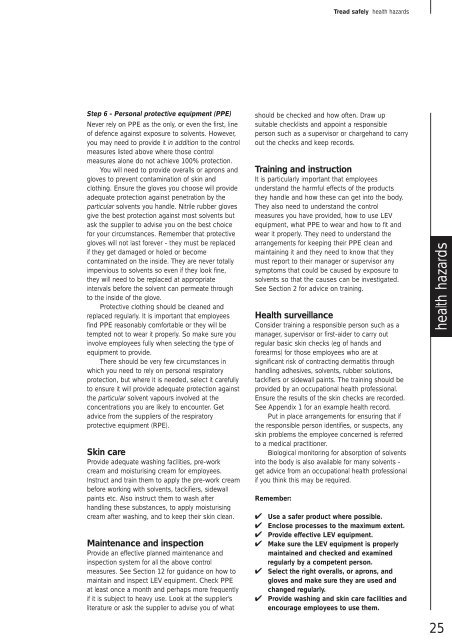INDG380 TREAD SAFELY - HSE
INDG380 TREAD SAFELY - HSE
INDG380 TREAD SAFELY - HSE
You also want an ePaper? Increase the reach of your titles
YUMPU automatically turns print PDFs into web optimized ePapers that Google loves.
Step 6 - Personal protective equipment (PPE)<br />
Never rely on PPE as the only, or even the first, line<br />
of defence against exposure to solvents. However,<br />
you may need to provide it in addition to the control<br />
measures listed above where those control<br />
measures alone do not achieve 100% protection.<br />
You will need to provide overalls or aprons and<br />
gloves to prevent contamination of skin and<br />
clothing. Ensure the gloves you choose will provide<br />
adequate protection against penetration by the<br />
particular solvents you handle. Nitrile rubber gloves<br />
give the best protection against most solvents but<br />
ask the supplier to advise you on the best choice<br />
for your circumstances. Remember that protective<br />
gloves will not last forever - they must be replaced<br />
if they get damaged or holed or become<br />
contaminated on the inside. They are never totally<br />
impervious to solvents so even if they look fine,<br />
they will need to be replaced at appropriate<br />
intervals before the solvent can permeate through<br />
to the inside of the glove.<br />
Protective clothing should be cleaned and<br />
replaced regularly. It is important that employees<br />
find PPE reasonably comfortable or they will be<br />
tempted not to wear it properly. So make sure you<br />
involve employees fully when selecting the type of<br />
equipment to provide.<br />
There should be very few circumstances in<br />
which you need to rely on personal respiratory<br />
protection, but where it is needed, select it carefully<br />
to ensure it will provide adequate protection against<br />
the particular solvent vapours involved at the<br />
concentrations you are likely to encounter. Get<br />
advice from the suppliers of the respiratory<br />
protective equipment (RPE).<br />
Skin care<br />
Provide adequate washing facilities, pre-work<br />
cream and moisturising cream for employees.<br />
Instruct and train them to apply the pre-work cream<br />
before working with solvents, tackifiers, sidewall<br />
paints etc. Also instruct them to wash after<br />
handling these substances, to apply moisturising<br />
cream after washing, and to keep their skin clean.<br />
Maintenance and inspection<br />
Provide an effective planned maintenance and<br />
inspection system for all the above control<br />
measures. See Section 12 for guidance on how to<br />
maintain and inspect LEV equipment. Check PPE<br />
at least once a month and perhaps more frequently<br />
if it is subject to heavy use. Look at the supplier’s<br />
literature or ask the supplier to advise you of what<br />
Tread safely health hazards<br />
should be checked and how often. Draw up<br />
suitable checklists and appoint a responsible<br />
person such as a supervisor or chargehand to carry<br />
out the checks and keep records.<br />
Training and instruction<br />
It is particularly important that employees<br />
understand the harmful effects of the products<br />
they handle and how these can get into the body.<br />
They also need to understand the control<br />
measures you have provided, how to use LEV<br />
equipment, what PPE to wear and how to fit and<br />
wear it properly. They need to understand the<br />
arrangements for keeping their PPE clean and<br />
maintaining it and they need to know that they<br />
must report to their manager or supervisor any<br />
symptoms that could be caused by exposure to<br />
solvents so that the causes can be investigated.<br />
See Section 2 for advice on training.<br />
Health surveillance<br />
Consider training a responsible person such as a<br />
manager, supervisor or first-aider to carry out<br />
regular basic skin checks (eg of hands and<br />
forearms) for those employees who are at<br />
significant risk of contracting dermatitis through<br />
handling adhesives, solvents, rubber solutions,<br />
tackifiers or sidewall paints. The training should be<br />
provided by an occupational health professional.<br />
Ensure the results of the skin checks are recorded.<br />
See Appendix 1 for an example health record.<br />
Put in place arrangements for ensuring that if<br />
the responsible person identifies, or suspects, any<br />
skin problems the employee concerned is referred<br />
to a medical practitioner.<br />
Biological monitoring for absorption of solvents<br />
into the body is also available for many solvents <br />
get advice from an occupational health professional<br />
if you think this may be required.<br />
Remember:<br />
✔ Use a safer product where possible.<br />
✔ Enclose processes to the maximum extent.<br />
✔ Provide effective LEV equipment.<br />
✔ Make sure the LEV equipment is properly<br />
maintained and checked and examined<br />
regularly by a competent person.<br />
✔ Select the right overalls, or aprons, and<br />
gloves and make sure they are used and<br />
changed regularly.<br />
✔ Provide washing and skin care facilities and<br />
encourage employees to use them.<br />
health hazards<br />
25

















